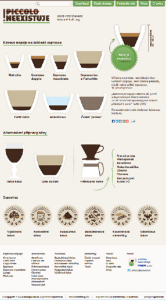
In 2010, a coffee consultancy called Kávový klub (Coffee Club), was founded “as a response to the need to promote knowledge about fine preparation of coffee in cafes as well as at homes in the Czech Republic.” The importance of knowledge in the area of food production and gastronomy is not a new thing and definitely not unique to the Czech Republic. Knowledge and expertise are important for the search for authenticity (Johnston and Baumann 2009) that is characteristic of today’s food culture and of what the sociologist Sharon Zukin (1991) has called “reflexive consumption.” However, in a post-socialist context, the struggle for the establishment of correct knowledge and ways of consumption also translates into questions, such as, have we caught up with the West yet? are we cultured enough?
Czech agents of civilization
The famous campaign of Kávový klub, called “Piccolo does not exist” is against using the word piccolo as an equivalent of espresso on menus in Czech restaurants and cafes. But that is not all:
It’s not so much the presence of the word piccolo in menus that bothers us; it is rather the degradation of the concept of espresso. A café that offers piccolo (even if it is of reasonable taste and the right parameters) also always offers espresso that does not represent anything that could be drinkable. That’s exactly what we would like to disappear from cafés – the terrible thing called by “wordly-minded Czechs” the “presso”. The only thing that can remain is the perfectly balanced and excellent tasting espresso, which a barista is able to pour, extract, describe and present.
At stake according the campaign organizers is not only knowledge itself but also culture. The motto of the campaign, which says: “Help us reinstate a coffee culture,” also implies that properly educated consumers can also become “civilizing agents” and can bring about the lost culture of drinking coffee.
English gentrifiers
But what should this “coffee culture” look like? I’ve recently started working in London. Having my couch-base in East London, I got to explore areas such as Hackney, Shoreditch, Bethnal Green, and Whitechapel – all areas with the nicest cafes and, I’d say, a good “coffee culture”. They’re also areas that have either already undergone heavy gentrification or are currently transforming.
Back in the 90’s, Sharon Zukin (1991: 214–215) argued that new cuisine was related to the phenomenon of gentrification. Both started becoming prominent in the 70’s, when new relations between production, investment, and consumption began to result in a new organization of consumption. This new form of consumption has been relying on “critical infrastructure,” that is, an infrastructure of agents that are critical of urban developments and produce critique. Concomitantly with them, a new group of consumers has emerged and distinguished itself from other groups through their “reflexive consumption.” Basically, what this means is that consumers who are conscious of their consumer choices need an infrastructure of people who can feed into their knowledge. That is why artists, foodies and yuppies hang out in the same area. And once the critical agents need to move elsewhere, they will be followed by the conscious consumers.
I’ve been reading The Guardian’s reports on gentrification of East London , including the protests against a place called Cereal Killer that sells a bowl of cereal for £4 and has become a symbol for the evils of gentrification. I think I might have become too much of a “reflexive consumer” myself to enter the place but I did go see it. It looked tiny and random and it could hardly be blamed for such a complex urban problem. (Could we blame the celebrity activist Russell Brand who opened Trew Era Cafe nearby allegedly using money he made off his book, Revolution?) Similarly, traditional Czech cafes and restaurants that offer piccolo can’t be blamed for keeping the country from becoming more westernized. But both Cereal Killer and piccolo have become useful as tools for navigating through change and transformation.
